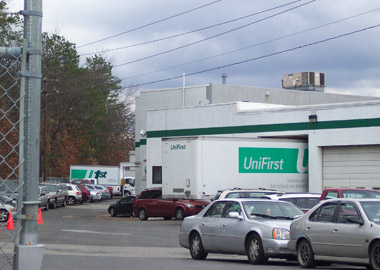In a move that may bring radioactivity closer to beautiful Dimmock Pond and nearby homes in Springfield’s Indian Orchard, the UniFirst company at 295 Parker Street is planning to acquire more than half an acre of Hubbard Park, which lies just outside UniFirst’s fence, to expand its parking area. UniFirst’s subsidiary UniTech, formerly Interstate Nuclear Services, launders uniforms contaminated with isotopes from nuclear installations such as power plants and laboratories.
The UniFirst plant has been operating on Parker Street since 1957, sending a slow trickle of water into the city’s sewer system—which is not illegal as long as the level of radioactivity doesn’t violate Nuclear Regulatory Commission standards. The company has always insisted it doesn’t—at least, not on average. In the past, varying levels of radiation have been detected near the company’s fence. UniFirst is nearly surrounded by homes; the part of its property in which nuclear uniforms are laundered is not marked with signs conspicuous enough to warn people walking on Parker Street or living in nearby houses of the presence of radioactivity.
On December 12 at 7 p.m. in the City Council chambers in City Hall, a hearing will be held on a zoning change for that part of Parker Street that would allow UniFirst to take over the narrow strip of Hubbard Park. City correspondence from late November shows that city officials and UniFirst hoped to bring up both the zoning change and a home rule petition for the transfer of the park property on that same night. UniFirst has said that in return for the property, it will make a cash payment to the city for improvements to Plastics Park, will provide unspecified “enhancements” to Hubbard Park, and will build a buffer between its property and the park.
UniTech is believed to be the oldest nuclear laundry in the world, and is now multinational. In addition to uniforms, it also decontaminates tools and respirators. It serves many U.S. government operations, including Oak Ridge, Sandia, Argonne, Lawrence Livermore and Brookhaven national laboratories and the U.S. Navy Nuclear Shipyards.



